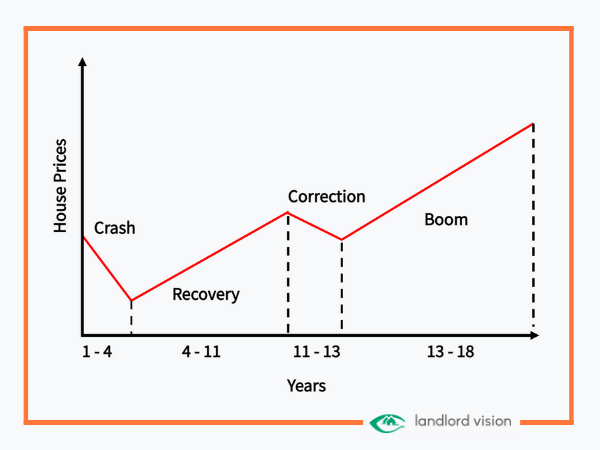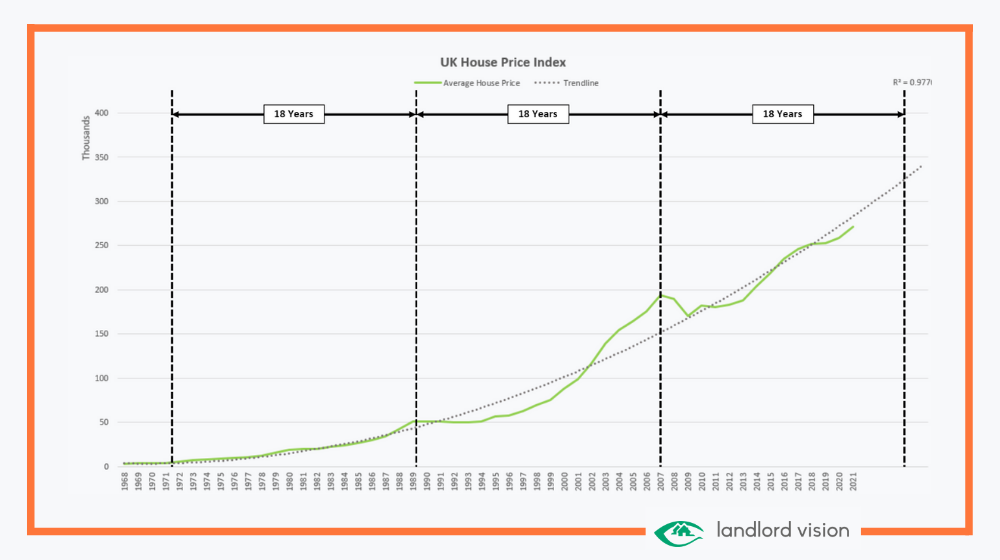
It is believed that the property market, both globally and in the UK, is driven by the Property Cycle. That is, the property market conforms to a repetitive and historical sequence of events which can be categorised. The Property Cycle is not unique, it ties in with the business cycle, credit cycle and a general theory of economic boom and bust.
Historically, whilst the Property Cycle has proved to be a useful tool for conceptualising the market and providing a framework for understanding different periods within the property market, few people have been able to use the theory to predict property prices. One of the few credible theories out there which claims to do this is the 18-Year Property Cycle.
What is the 18-year Property Cycle?
Fred Harrison rose to fame for predicting the 2007-08 financial crash as early as 1998. In 2005 he released a book titled ‘Boom and Bust’, which argued that the UK property market follows an 18-year cycle. To support his argument, Harrison demonstrated how the 18-Year Cycle repeated consistently throughout 200 years of UK house price data. The market crashes of 1953-54, 1971-72 and 1989-90 all lend support to Harrison’s claims.
The theory suggests that following a crash, the property market experiences 3-4 years of recession. Lenders and investors withdraw from the market and demand for property dries up, leaving the abundance of supply planned during the boom to draw down house prices. Following this comes the recovery phase, where confidence slowly begins to return and prices creep up for 6-7 years.
After the recovery phase, there is a small market correction where prices pause for breath. This typically lasts 1-2 years and occurs as investors become nervous about the sustainability of growth. From then on, the boom phase kicks in. Government stimulus and low borrowing requirements fuel demand, with supply failing to keep pace. This results in a period of strong house price and rental growth over 5-6 years. The subsequent peak and crash signals the start of the next cycle.

Why is the 18 Year Property Cycle Important?
Property Cycle theories are nothing new. What is important about this theory is that it adds timeframes to the Property Cycle argument. It is measurable and can be tested using historical data. As such, Boom and Bust is an interesting read for any would-be property investor or economist.
Even with the best pedigree, theories such as the 18-Year Property Cycle should be taken with a pinch of salt. That being said, when theories like this gain popularity, they can become self-fulfilling prophecies. An increasing number of investors and commentators are posting about and discussing the 18-Year cycle. When enough people begin to plan with this in mind, do not be surprised when the predictions begin to come to fruition.
Where in the 18 Year Cycle are we?
If the 18-Year Cycle is correct, the UK property market will have entered its boom phase around 2019-20. Interestingly, this coincides with the rampant house price growth witnessed over the past 12 months. With house prices increasing 8.6% over the past 12 months, government schemes to incentivise the housing market and more readily available finance in the form of 95% mortgages, there are certainly hallmarks of a boom phase.

Were the 18-Year Cycle to play out as would be anticipated, it would suggest that there are 3-4 years more of booming house price growth before the inevitable crash. A simple trendline would suggest that this could result in prices continuing to rise another 25% from current levels. No-doubt a welcome thought for any property investor.
However, we are not in ordinary times. Coronavirus is a once in a century occurrence and, as Harrison himself admits, such events can impact the cycle – much as the first and second world war did. What is more, there is only so far the property prices can rise whilst wages remain stagnant. Therefore, depending on your conviction, it might make sense to plan for the worst and hope for the best.
Disclaimer: This ‘Landlord Vision’ blog post is produced for general guidance only, and professional advice should be sought before any decision is made. Nothing in this post should be construed as the giving of advice. Individual circumstances can vary and therefore no responsibility can be accepted by the contributors or the publisher, Landlord Vision Ltd, for any action taken, or any decision made to refrain from action, by any readers of this post. All rights reserved. No part of this post may be reproduced or transmitted in any form or by any means. To the fullest extent permitted by law, the contributors and Landlord Vision do not accept liability for any direct, indirect, special, consequential or other losses or damages of whatsoever kind arising from using this post.



